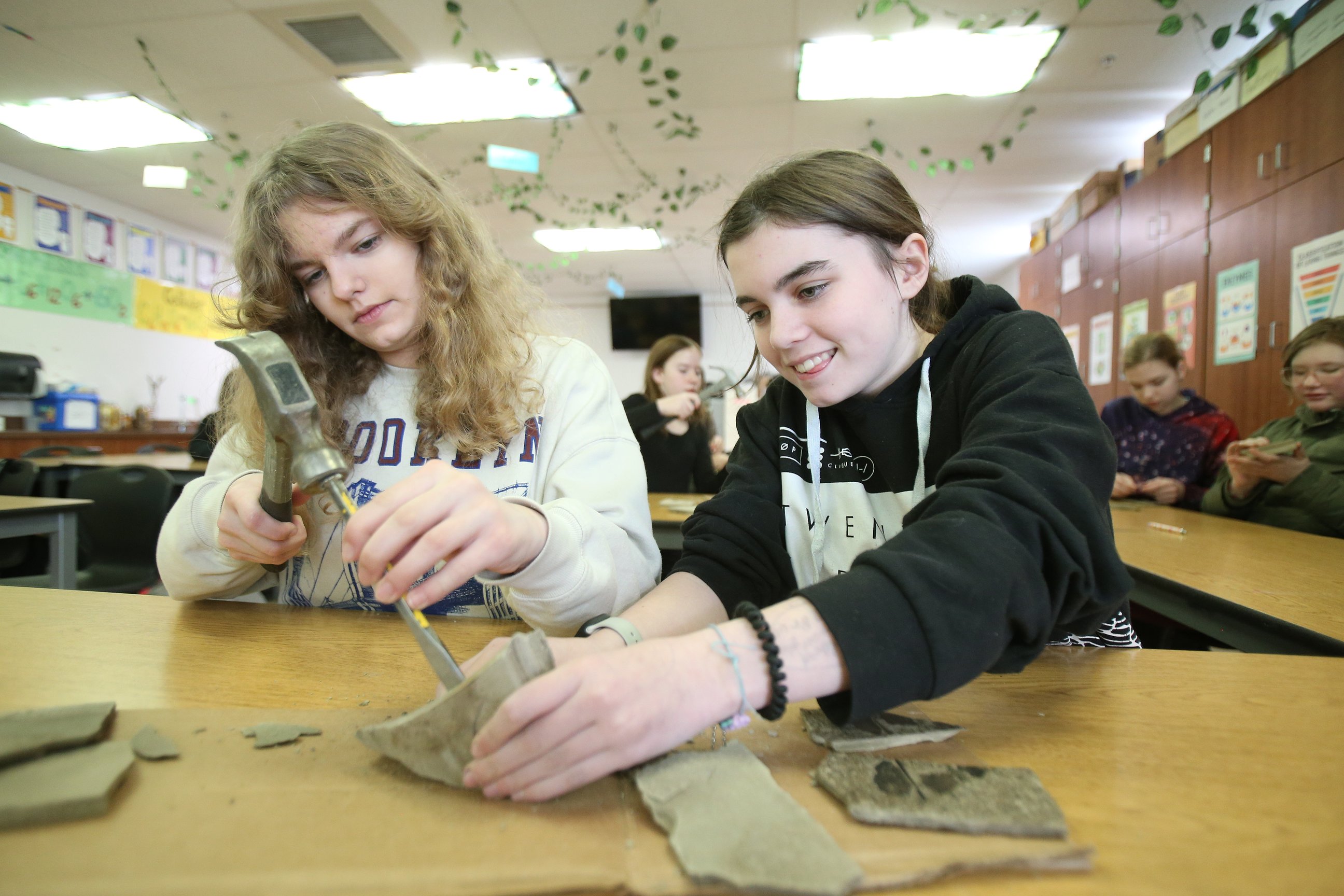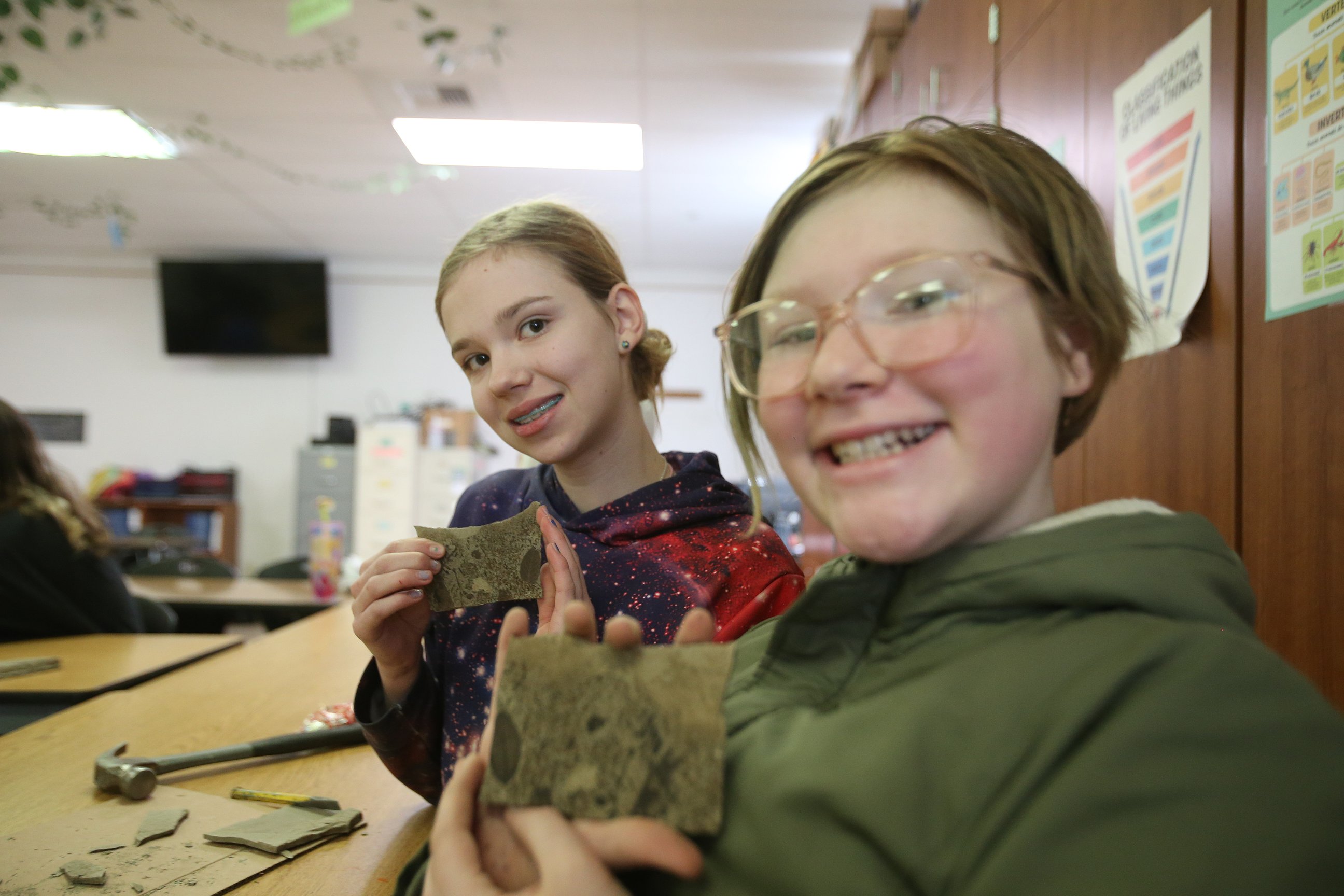Coeur d'Alene middle schoolers hunt for fossils within ancient rocks
COEUR d'ALENE — Tap, chip, tap, chip, tippity tap tap tap ... Eureka!
"We actually split it!" Lakes Middle School seventh grader Alex Terry announced Thursday morning in Allison Frazier's class as he and classmate Ruby Zaike worked open a piece of ancient sedimentary shale.
"We don't know what it is," Alex said, examining the impression.
At another table, Bella Dirks and Taitum Ellis chipped into a different piece of 50-million-year-old history.
"I see a crack right here," Bella said, tapping a chisel into the shale.
"I got like rocks in my eyes!" Taitum said.
Guests from Stonerose Interpretive Center and Eocene Fossil Site in Republic, Wash., have visited middle school classrooms this week sharing the joy of discovery with aspiring paleontologists in the Coeur d'Alene School District.
"This is so cool," seventh grader Atticus Wintzer said. "I love anything with nature, natural resources, fossils. It's so cool."
She and classmate Brooklyn Blair uncovered imprints of whole leaves, tiny fronds and a smattering of other organic matter in their shale pieces.
"I like the suspense," Brooklyn said.
The Stonerose visit was paid for by a $6,365.44 EXCEL Foundation grant received by Woodland Middle School science teacher Karina Hogan. Stonerose visited Canfield and Woodland middle schools earlier in the week.
Hogan said the seventh grade life science curriculum includes the expectation that students analyze the fossil record.
"This can be a somewhat dry topic for 12- and 13-year-olds, and I was striving to find a way to make it more exciting, applicable and hands-on," she said. "After the first time we invited Stonerose to host this event in 2019, I realized this was the solution. The students at all of the middle schools loved this event."
This was the fourth time Stonerose visited Coeur d'Alene's schools.
"We are so grateful to the EXCEL Foundation for funding this opportunity," Hogan said. "Every kid walked away with a fossil; some with many, many more than one. I overheard some students talking about how they were going to make their fossil into a piece of jewelry; many other creative ideas were floated as to what they would do with their fossils when they got home.
"They were so proud of their 50-million-year-old fossils, they couldn't wait to share them with their classmates and families," she said. "This is an opportunity that some students may never get again and I'm happy to have facilitated that experience."
Stonerose Fossils Director Travis Wellman gave presentations about the quarry, where impressions of all sorts of Eocene Epoch flora and fauna have been found, including over 200 genres of insects. This area was part of an ancient lake 50 million years ago. Over time, layers of sediment built up on the lakebed, with an abundance of ash present from volcanic activity that occurred in the area at the time. This turned into fine-grained tuffaceous shale, layers of which can be split apart like book pages.
Stonerose has been bringing knowledge and examples of ancient natural history into classrooms for at least 20 years.
"It's fantastic knowing that you're potentially inspiring people to go into the sciences," Wellman said.
He said a few years ago, the paleontology-centered nonprofit received a letter from a Massachusetts Institute of Technology student who had participated in fossil-cracking activities with Stonerose as a child.
"He wrote us a letter just saying, 'Hey, my experience with Stonerose got me into science. Although it's not paleontology, here I am at MIT,'" Wellman said. "It just makes you feel really good to know you're making a difference like that."





